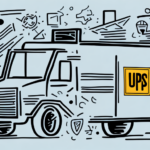A Comprehensive Guide to UPS Shipping Rates
In the ever-evolving landscape of online shopping and e-commerce, shipping rates are pivotal to the success of any business. UPS, one of the world's leading package delivery companies, provides a myriad of shipping options tailored for businesses of varying sizes and needs. This guide offers an in-depth analysis of UPS shipping rates, empowering you to make informed decisions about your shipping strategies.
Understanding UPS Shipping Zones
The primary determinant of UPS shipping rates is the shipping zone. UPS segments the United States into distinct zones based on the distance between the package's origin and its destination. Proximity to the origin results in lower shipping rates, whereas shipping to more distant zones incurs higher costs.
UPS utilizes nine shipping zones within the U.S., with Zone 1 being the nearest and Zone 9 the farthest. Accurately identifying your package’s zone is essential before calculating shipping costs. For international shipments, UPS also employs shipping zones, though the number and distance between zones can vary by country. Utilize UPS’s online tools or consult UPS directly to determine the appropriate shipping zone for international packages.
Calculating Shipping Costs with UPS
UPS determines shipping rates based on multiple factors, including:
- Package Weight: Heavier packages generally incur higher shipping rates.
- Package Dimensions: Larger packages, even if lighter, may cost more due to the space they occupy.
- Destination: As mentioned, shipping zones influence the cost based on distance.
- Service Level: UPS offers various service levels such as Ground, Next Day Air, 2nd Day Air, and 3 Day Select, each with different delivery times and rates.
- Item Type: Specific items like hazardous materials or fragile goods may require additional handling, increasing costs.
Additionally, UPS provides discounts for high-volume shippers. Businesses that frequently ship large quantities may benefit from negotiated rates, potentially reducing overall shipping expenses.
According to UPS’s 2023 Annual Report, their Ground service accounts for approximately 50% of their domestic shipments, highlighting its significance for cost-effective shipping solutions (source).
Comparing UPS Shipping Rates to Other Carriers
When selecting a shipping carrier, it's crucial to compare UPS’s rates with those of other providers to ensure you receive the most cost-effective and reliable service. Here’s how UPS stacks up against its competitors:
- USPS: Often more affordable for small packages and offers competitive rates for Priority Mail, though it may lack the extensive tracking features UPS provides.
- FedEx: Tends to offer competitive international rates and faster delivery options, making it a suitable alternative for time-sensitive or global shipments.
Beyond cost, consider each carrier’s service quality, reliability, and network accessibility. UPS is renowned for its robust tracking capabilities and expansive global network, which can enhance delivery reliability and customer satisfaction.
Tips to Save Money on UPS Shipping Rates
Optimizing your UPS shipping costs can significantly impact your bottom line. Here are several strategies to consider:
- Choose Ground Shipping: Opting for UPS Ground over air services can lead to substantial savings, especially for non-urgent deliveries.
- Negotiate Rates: Businesses with consistent, high-volume shipping can negotiate better rates with UPS. Engage with a UPS account manager to explore available discounts.
- Utilize UPS Online Tools: Leverage UPS’s free online tools for cost estimation, shipment tracking, and managing shipping preferences to enhance efficiency and reduce costs.
- Consolidate Shipments: Combining multiple packages destined for the same location can lower overall shipping expenses through bulk shipping rates.
- Proper Packaging: Adhering to UPS’s packaging guidelines minimizes the risk of additional fees due to oversized or improperly packaged items.
Negotiating Better Shipping Rates with UPS
For businesses that consistently ship with UPS, negotiating better shipping rates can yield significant savings. Follow these steps to enhance your negotiation outcomes:
- Demonstrate Shipping Volume: Present UPS with detailed records of your shipping volume and frequency to establish your eligibility for volume-based discounts.
- Shop Around: Gather competitive rate quotes from other carriers to use as leverage in negotiations.
- Commit to Long-Term Contracts: Offering to enter into a long-term agreement can incentivize UPS to provide more favorable rates.
- Leverage Third-Party Services: Consider using third-party negotiation services that specialize in securing better rates for businesses.
Additionally, staying informed about UPS’s latest services and rate changes enables you to negotiate effectively and ensure you’re receiving the best possible rates.
Understanding UPS Ground, Air, and International Shipping Rates
UPS offers diverse shipping options, each tailored to different needs and accompanied by distinct rate structures:
- UPS Ground: The most economical choice for domestic shipments, with rates influenced by package weight, dimensions, and distance.
- UPS Air: Includes Next Day Air, 2nd Day Air, and 3 Day Select. Air shipping delivers faster times but at a higher cost.
- UPS International Shipping: Rates vary based on the destination country, package specifics, and chosen service level.
While UPS Ground is cost-effective, it’s best suited for non-urgent shipments as delivery can take several days. In contrast, UPS Air services are ideal for time-sensitive packages.
Furthermore, UPS provides comprehensive tracking across all shipping options, with more detailed updates for Air and International services compared to Ground shipments.
The Impact of Package Size and Weight on UPS Shipping Rates
Both the size and weight of a package are critical factors influencing UPS shipping rates:
- Weight: Heavier packages result in higher shipping fees.
- Dimensions: Larger packages, which occupy more space, may incur additional charges even if they are lighter in weight.
Accurate measurement of both weight and dimensions is imperative for precise rate estimation. Shipping to remote or rural areas can also increase costs due to extended transportation requirements. International shipping might further escalate costs owing to customs duties and varying regulations.
Selecting an appropriate shipping service in line with your package’s characteristics can help optimize costs and ensure timely delivery. For example, UPS Proactive Address Correction can help avoid delays and additional fees associated with incorrect or incomplete addresses.
Using UPS's Online Tools to Estimate Shipping Costs and Track Packages
UPS provides a suite of online tools designed to streamline your shipping process:
- Shipping Calculator: Enter package details, including dimensions, weight, and destination, to receive an estimated shipping cost instantly.
- Package Tracking: Monitor your shipments in real-time, with detailed tracking information available for each shipping option.
- UPS My Choice: Customize delivery preferences, receive notifications, and manage delivery options to enhance control over your shipments.
- Rate and Service Comparison: Compare different UPS services to determine the most cost-effective and suitable option for your needs.
Leveraging these tools can lead to more efficient shipping management, potential cost savings, and improved delivery reliability.
A Guide to UPS's Additional Services and Fees
Beyond standard shipping options, UPS offers a range of additional services and incur optional fees to enhance your shipping experience:
- Insurance: UPS offers declared value coverage to protect high-value shipments against loss or damage.
- Signature Confirmation: Ensure the secure delivery of packages by requiring a signature upon receipt.
- UPS Access Point: Allows recipients to collect their packages from convenient locations instead of their address.
- Residential Surcharge: An additional fee applied when delivering to residential addresses, reflecting the extra costs associated with such deliveries.
Understanding these additional services and associated fees enables you to tailor your shipping practices to meet specific business needs while managing costs effectively.
Handling Disputes or Claims with UPS for Shipping Rates
Even with meticulous planning, issues may arise in your shipping process that necessitate disputes or claims. To address problems related to UPS shipping rates or services:
- Filing a Claim: Use UPS’s online claims portal or contact customer service to report issues such as lost or damaged packages.
- Provide Documentation: Submit relevant documents, including shipping receipts, tracking numbers, and evidence of loss or damage, to support your claim.
- Follow Up: Maintain communication with UPS representatives to track the progress of your claim and ensure resolution.
Prompt and clear communication, along with comprehensive documentation, facilitates the effective resolution of disputes and claims with UPS.
Best Practices for Packaging and Labeling Your Shipments
Proper packaging and labeling are essential to ensure the safe and efficient delivery of your shipments. Adhering to these best practices can help minimize delays, prevent damage, and avoid additional fees:
- Use Sturdy Packaging: Select durable boxes and materials to protect the contents of your shipment. Reinforce edges and seams with strong tape to enhance package integrity.
- Accurate Labeling: Clearly print the recipient's name, address, and contact information, as well as your return address. Ensure labels are legible and securely attached to the package.
- Include a Packing Slip: Attach a packing slip or invoice inside the package to provide details about the contents, facilitating smooth processing and handling.
- Follow UPS Guidelines: Adhere to UPS’s packaging guidelines to avoid additional charges and ensure compliance with UPS standards.
Case Studies: How Different Businesses Utilize UPS Shipping Rates
Examining real-life examples can provide valuable insights into how various businesses leverage UPS shipping rates to optimize their operations:
Case Study 1: E-commerce Retailer
An online retailer specializes in electronics and frequently ships to customers nationwide. By utilizing UPS Ground, the retailer minimizes shipping costs for non-urgent deliveries. Additionally, by negotiating higher-volume discounts with UPS, they secure lower rates, enhancing profit margins.
Case Study 2: Manufacturing Company
A manufacturing company regularly ships bulk orders to distributors. They consolidate multiple shipments into single consignments to benefit from bulk shipping rates. By leveraging UPS’s online tracking tools, they maintain visibility over their shipments, ensuring timely arrivals and improving distributor satisfaction.
Case Study 3: International Distributor
An international distributor relies on UPS Air services for time-sensitive shipments. By selecting Next Day Air, they ensure rapid delivery to overseas clients. Additionally, the company uses UPS’s declared value insurance to protect high-value goods, mitigating financial risks associated with shipping.
These case studies illustrate how businesses across different industries can strategically utilize UPS shipping rates and services to meet their specific needs, achieve cost savings, and ensure reliable delivery.




















